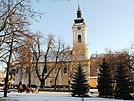Kikinda
| |
|---|---|
| City of Kikinda | |
|
From top: Rotonda building, National Museum & Archive of Kikinda, Mammoth Kika sculpture, Villa Rizenfelder, Saint Nichola's Church, Suvača- horse mill, Kikinda's pond | |
 Location of the city of Kikinda (red) within Serbia | |
| Coordinates: 45°50′N 20°27′E / 45.833°N 20.450°E | |
| Country | |
| Province | |
| Region | Banat |
| District | North Banat |
| Municipality | Kikinda |
| City status | March 2016 |
| Government | |
| • Mayor | Mladen Bogdan (SNS) |
| Area | |
| • Rank | 20th in Serbia |
| • Urban | 189.68 km2 (73.24 sq mi) |
| • Administrative | 782.46 km2 (302.11 sq mi) |
| Elevation | 78 m (256 ft) |
| Population (2022 census)[1] | |
| • Rank | 25th in Serbia |
| • Urban | 32,084 |
| • Urban density | 170/km2 (440/sq mi) |
| • Administrative | 49,326 |
| • Administrative density | 63/km2 (160/sq mi) |
| Demonym(s) | Kikinđani, (sr) |
| Time zone | UTC+1 (CET) |
| • Summer (DST) | UTC+2 (CEST) |
| Postal code | 23300 |
| Area code | +381(0)230 |
| ISO 3166 code | SRB |
| Car plates | KI |
| Website | kikinda |
Kikinda (Serbian Cyrillic: Кикинда, pronounced [kǐkiːnda]; Hungarian: Nagykikinda) is a city and the administrative center of the North Banat District in Serbia. The city's urban area has 32,084 inhabitants, while the city administrative area has 49,326 inhabitants.
The city was founded in the 18th century. From 1774 to 1874 Kikinda was the seat of the District of Velika Kikinda, an autonomous administrative unit of Habsburg monarchy. In 1893, Kikinda was granted the status of a city. The city became part of the Kingdom of Serbia (and Kingdom of Serbs, Croats and Slovenes) in 1918, and it lost the city status. The status was re-granted in 2016.
In 1996, the well-preserved archaeological remnants of a half a million-year-old mammoth were excavated on the outer edge of the town area.[2] The mammoth called "Kika" has become one of the symbols of the town. Today it is exhibited in the National Museum of Kikinda. Other attractions of the city are the Suvača – a unique horse-powered dry mill, the annual Pumpkin Days[3] and the International Symposium of Sculpture "Terra".[4] The winter roosts of long-eared owl, with a large number of individuals, are easily accessible as they are situated in town parks and attract birdwatchers both from this country and abroad.
- ^ "2011 Census of Population, Households and Dwellings in the Republic of Serbia: Comparative Overview of the Number of Population in 1948, 1953, 1961, 1971, 1981, 1991, 2002 and 2011, Data by settlements" (PDF). Statistical Office of Republic Of Serbia, Belgrade. 2014. ISBN 978-86-6161-109-4. Retrieved 27 June 2014.
- ^ Cite error: The named reference
kikawas invoked but never defined (see the help page). - ^ Cite error: The named reference
daniwas invoked but never defined (see the help page). - ^ The "TERRA" Centre for fine and applied arts Archived 17 January 2010 at the Wayback Machine







